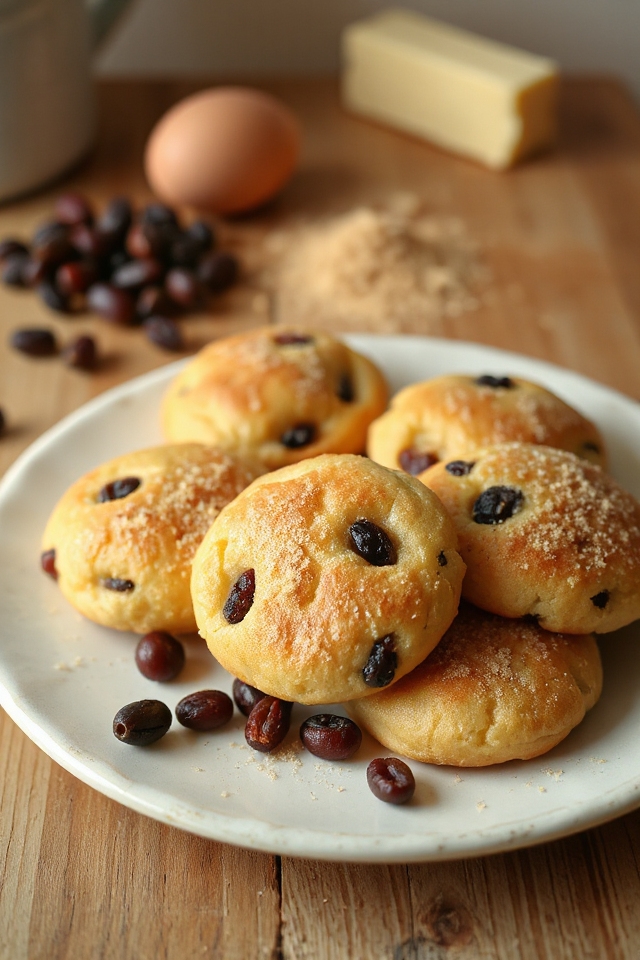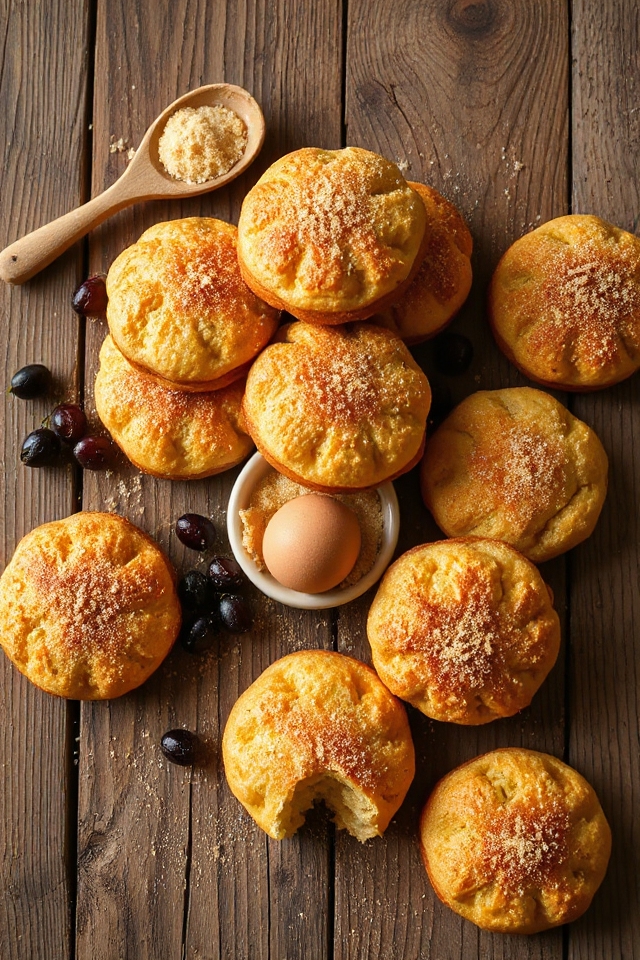Why You’ll Love This Welsh Cakes Recipe
Welsh cakes are a delightful treat that blend the richness of butter with the sweetness of currants. I love how they capture the essence of traditional Welsh baking, bringing warmth and comfort with every bite.
The texture is perfectly balanced—crispy on the outside and soft on the inside. Making them is a joyful experience; the aroma fills my kitchen, creating a cozy atmosphere.
Whether enjoyed with a cup of tea or as a quick snack, they never fail to impress. Plus, they’re easy to whip up, making them a go-to recipe for any occasion.
Trust me, you’ll adore them!
Ingredients of Welsh Cakes
When it comes to making Welsh cakes, the ingredients are simple yet essential for achieving that delightful flavor and texture. You’ll find that each component plays a role in creating that perfect blend of buttery goodness and sweet currants that makes these treats so irresistible.
Plus, you probably have most of these ingredients in your pantry already, which is always a win. Let’s take a closer look at what you’ll need to whip up a batch of these charming little cakes.
Ingredients:
- 115 g butter, cut into pieces
- 225 g self-raising flour
- 85 g golden caster sugar
- 85 g currants
- 1 egg, beaten
- Sunflower oil, for greasing
Now, let’s chat a bit about these ingredients. First off, the butter is where all that rich flavor comes from, so don’t skimp on it—go for the good stuff.
Self-raising flour is a bit of a lifesaver here; it does the heavy lifting by helping your cakes rise beautifully without needing to measure out yeast or baking powder.
And those golden caster sugar crystals? They add just the right amount of sweetness without making things too sugary.
You might be tempted to swap out currants for raisins or even chocolate chips (trust me, I’ve made that mistake before), but stay true to the recipe for that authentic Welsh experience.
And don’t forget a little pinch of salt—it really helps to balance the sweetness.
How to Make Welsh Cakes

Making Welsh cakes is like starting a delightful culinary adventure. First things first, grab your 115 g of butter and cut it into pieces. Now, here’s a little tip: make sure the butter is at room temperature; it makes the whole process a lot smoother. Toss that butter into a mixing bowl with 225 g of self-raising flour and a pinch of salt.
This is where the magic begins—rub the butter into the flour with your fingertips until it resembles breadcrumbs. I always like to pretend I’m a baker in a fancy cooking show during this part, even though my kitchen is probably a mess. Add in 85 g of golden caster sugar and 85 g of currants, and give it a good stir. The sweet smell is already wafting through the air, isn’t it?
Now, pour in 1 beaten egg and mix it all into a dough. Don’t be shy; get your hands in there. Once your dough is formed, turn it out onto a floured surface and roll it out to about 1 cm thick. You can feel the excitement building up now.
Use a 6.5-inch fluted cutter to stamp out rounds, and don’t worry if you have some trimmings left over; just re-roll them and keep going. Here comes the fun part—heat up your trusty cast iron griddle or a heavy-based frying pan on low heat. A little drizzle of sunflower oil will keep things from sticking.
To test if it’s hot enough, toss a sprinkle of water on the pan; if it sizzles, you’re golden. Cook each Welsh cake for about 5-6 minutes on each side, keeping an eye on them so they don’t burn. If they start browning too quickly, just lower the heat a smidge. Once they’re beautifully golden, transfer them to a wire rack to cool.
And there you have it, warm Welsh cakes ready to be sprinkled with a little extra caster sugar. Serve them up and watch as everyone’s eyes light up. Honestly, who can resist a warm, buttery treat like that?
Just remember, the best part about making these cakes is sharing them (or not, no judgment here). Enjoy the process, and don’t stress if they don’t turn out perfectly; they’ll still taste amazing, and you’ll have a great story to tell.
Welsh Cakes Substitutions & Variations
If you’re looking to mix things up with your Welsh cakes, there are plenty of substitutions and variations to explore.
I often swap currants for raisins or sultanas for a different flavor profile. You can also add spices like cinnamon or nutmeg for warmth.
If you prefer a healthier twist, substitute half the flour with whole wheat flour. For a dairy-free version, use coconut oil instead of butter.
You could even experiment with adding lemon zest or chopped nuts for an extra crunch. The possibilities are endless, so don’t hesitate to get creative with your Welsh cakes!
Additional Tips & Notes
Experimenting with substitutions and variations can make your Welsh cakes even more delightful. Don’t hesitate to swap currants for sultanas or even chocolate chips for a sweet twist.
If you’re aiming for a richer flavor, try adding a splash of vanilla extract or a pinch of nutmeg.
When it comes to cooking, keep an eye on the heat; too high and they’ll burn, too low and they won’t cook through.
I also recommend enjoying them warm, sprinkled with a bit of caster sugar, or even with a smear of butter. Trust me, it’s worth it!
